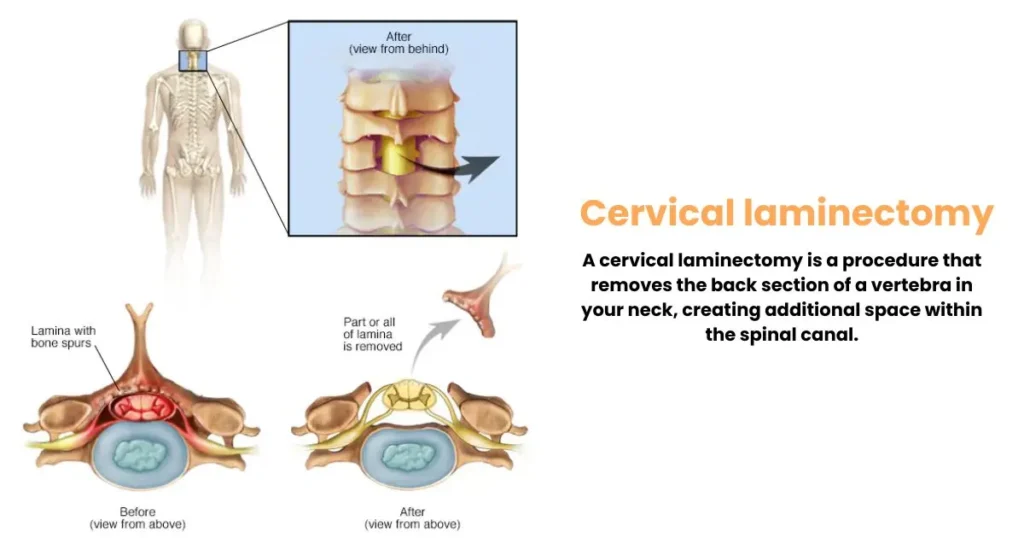How to Manage Cervical Pain:
How to Manage Cervical Pain:5 Effective Methods for Lasting Relief 1. Cervical Pain: An Overview Cervical pain, or neck pain,

A laminectomy is a surgical procedure that involves removing a portion of the spinal bone called the lamina, which forms part of the vertebral arch covering the spinal canal. This procedure is performed to enlarge the spinal canal and reduce pressure on the spinal cord or nerves. Often, a laminectomy is part of a broader decompression surgery aimed at alleviating spinal pressure.
The pressure in the spinal canal usually results from bony overgrowths, commonly referred to as bone spurs. These bone spurs often develop due to the natural aging process and are associated with arthritis in the spine. In some cases, genetic factors make individuals more prone to developing bone spurs.
Laminectomy is typically considered when conservative treatments, such as medication, physical therapy, or injections, fail to alleviate symptoms. It may also be recommended if symptoms are severe or worsening significantly.
Bony overgrowths in the spine’s joints can accumulate within the spinal canal, narrowing the space for the spinal cord and nerves. This compression can lead to pain, weakness, or numbness that may spread down the arms or legs.
Laminectomy helps by restoring space in the spinal canal, easing the pressure responsible for radiating pain. However, it does not address the underlying arthritis causing the narrowing, so it may not alleviate back pain entirely.
A healthcare provider might recommend a laminectomy if:
Conservative treatments like medications or physical therapy haven’t improved the symptoms.
Muscle weakness or numbness affects the ability to stand or walk.
Symptoms involve a loss of bowel or bladder control.
In some cases, laminectomy is part of a procedure to treat a herniated spinal disc, where removing part of the lamina allows the surgeon to access and repair the damaged disc.
Lower back or neck pain can vary in intensity, from mild and bothersome to severe and disabling. Spinal pain can limit your movement and affect daily functioning. A laminectomy may be recommended to relieve pressure on the spinal nerves, address a disc problem, or remove a spinal tumor.
One of the most common reasons for laminectomy is a herniated disc. A disc can become displaced or damaged due to injury or wear and tear, leading to pain, numbness, or weakness. When the disc presses on the spinal nerves, these symptoms can radiate to other parts of the body, often affecting the arms or legs. A typical sign of a herniated disc is sciatica, which is characterized by sharp, shooting pain along the sciatic nerve that runs from the buttocks to the leg.
When conservative treatments are no longer effective, surgery may become necessary. Some non-surgical treatment options include:
Laminectomy is typically performed for persistent back or neck pain that does not improve with conservative medical treatments. It is also indicated when the pain is associated with symptoms of spinal cord or nerve injury, such as numbness or weakness in the arms or legs. Additionally, if there is loss of bowel or bladder control due to pressure on the cervical or lumbar spine, surgery is often necessary.
Your healthcare provider may suggest a laminectomy for other reasons as well, based on your specific condition and symptoms.
Laminectomy is generally a safe procedure. However, like any surgery, it carries potential risks. Possible complications include:
You’ll need to avoid eating or drinking for a certain period before surgery. Your healthcare team will give you specific instructions on which medications to take or avoid prior to the procedure.
Laminectomy is typically performed under general anesthesia, meaning you’ll be asleep and won’t feel pain during the surgery. Your surgical team will monitor your heart rate, blood pressure, and oxygen levels throughout the procedure.
The surgeon will make an incision over the affected vertebrae and carefully move the muscles aside to access the spine. Using small instruments, they’ll remove bone spurs and only the necessary amount of lamina. The incision size can vary based on the severity of your condition and your body size, with minimally invasive procedures often using smaller incisions than open surgeries.
If your surgery involves a herniated disk, the surgeon will perform a diskectomy to remove the herniated portion and any loose fragments. In cases where the vertebrae have slipped or there’s curvature in the spine, spinal fusion may be performed to stabilize the spine using bone grafts, rods, or screws. Minimally invasive techniques may also be used, involving a smaller incision and specialized surgical tools.
Post-surgery, you’ll be taken to a recovery room where the medical team will monitor you for any complications from the surgery or anesthesia. You may be asked to move your arms and legs, and pain medication will likely be prescribed to manage discomfort at the incision site.
Most patients spend one or two nights in the hospital. Physical therapy may be recommended to help regain strength and flexibility. Depending on your job’s physical demands, you may return to work in a few weeks. However, if spinal fusion was involved, recovery time may be longer.
Many people experience relief from symptoms after a laminectomy, particularly reduced radiating pain in the leg or arm. However, the improvement in back pain may be less significant and could diminish over time due to arthritis.
Thanks For Read
How to Manage Cervical Pain:5 Effective Methods for Lasting Relief 1. Cervical Pain: An Overview Cervical pain, or neck pain,
What is Spinal stenosis - Symptoms and causes & Treatment Spinal stenosis occurs when the space within the spine becomes
Spondylosis (Cervical) – Symptoms, Causes and Treatment Cervical spondylosis, often referred to as arthritis of the neck, describes the wear
Sciatica: Causes, Symptoms, Diagnosis, Treatment & Management A herniated disk is a condition that affects the rubbery cushions, known as
Sciatica: Causes, Symptoms, Diagnosis, Treatment & Management What is sciatica? Sciatica refers to pain that arises from irritation or injury